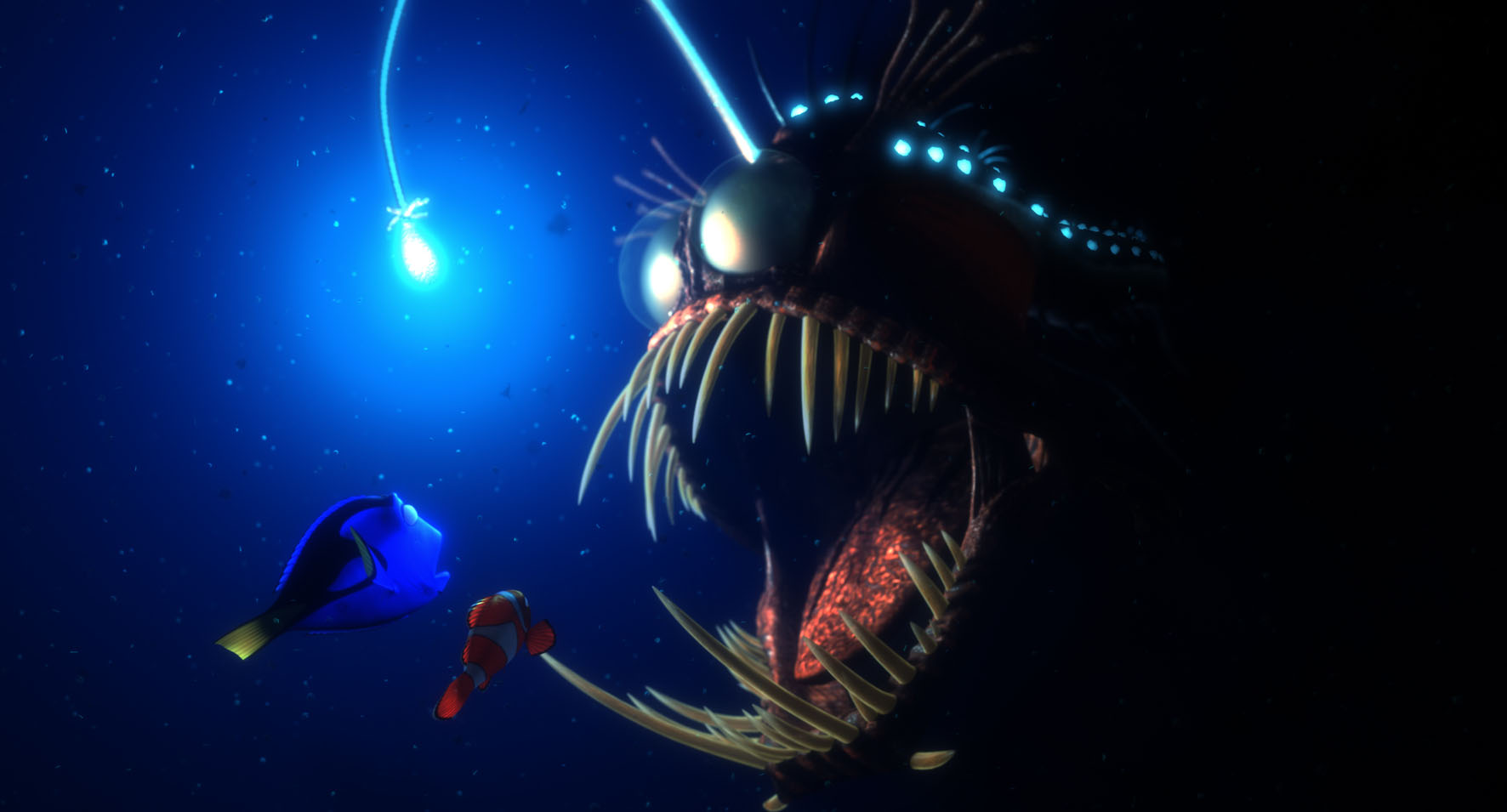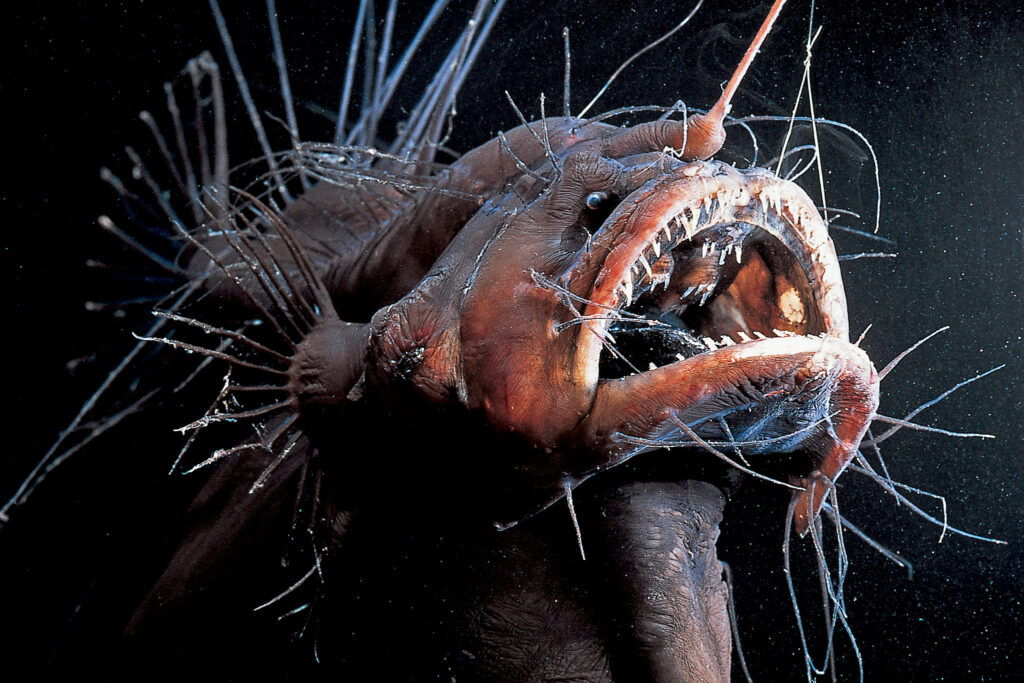The anglerfish is a solitary marine creature that lives in the depths and is called many names, such as the sea goblin with jagged teeth, the naughty dreamer, the tyrannical frog, or the wolf trap.
Also, some species of anglerfish are called “devilfish”, these many names are due to the anglerfish’s different shapes. Some are spherical and round, while others are flat and have a huge snout.
The first angler fish known to mankind was in 1833 when the sea threw a spherical fish onto one of the beaches of Greenland.
It was known by this name because of its fin or appendage that protrudes from the front of its head, which it uses to catch its food because it resembles the bait that is placed on a hook.
Anglerfish, of all kinds, represent a terrifying nightmare for small marine creatures that live in the oceans.
They quietly lurk like a hunter in the dark, waiting for the prey to approach, using the glowing appendage to attract their victim and then quietly devour them.
Most anglerfish have a wide mouth. It has the ability to massively inflate its jaw and stomach, allowing it to swallow prey up to twice the size of the anglerfish’s body.

First three spines!
The name “anglerfish” derives from the species’ characteristic method of predation. Anglerfish typically have at least one long filament sprouting from the middle of their heads, termed the illicium.
The illicium is the detached and modified first three spines of the anterior dorsal fin. In most anglerfish species, the longest filament is the first.
This first spine protrudes above the fish’s eyes and terminates in an irregular growth of flesh (the esca), and can move in all directions.
Fish of the teleost order Lophiiformes!
The anglerfish are fish of the teleost order Lophiiformes they are bony fish named for their characteristic mode of predation, and have a very strange method of hunting their victims, which scientists call the ambush method.
It is aided in this by its mouth, which resembles a hut, and the long, strong fin, which is very similar to a hook attached to the head above the mouth.
In which a modified luminescent fin ray (the esca or illicium) acts as a lure for other fish.

The luminescence comes from symbiotic bacteria, which are thought to be acquired from seawater that dwells in and around the sea.
The secret of both its jaw and its stomach!
Anglerfish extend along the eastern Atlantic Ocean, and along the Norwegian coast from the southwestern Barents Sea down to the Strait of Gibraltar, and include the Mediterranean Sea and the Black Sea.
There are also records from Icelandic waters. Anglerfish frequent areas of the deep coastal continental shelf, and Sandy or muddy sea floor, at depths ranging from 20 to 1000 meters
The anglerfish can distend both its jaw and its stomach, since its bones are thin and flexible, to enormous size, allowing it to swallow prey up to twice as large as its entire body
The Strangest fish ever, especially in its males!
The anglerfish is one of the strangest fish ever, especially in its males, which feed and mate by attaching the male to one of the females, merging with her body and feeding on her blood.
Free-living males and unparasitized females in these species never have fully developed gonads. Thus, males never mature without attaching to a female, and die if they cannot find one
Therefore, the female’s length reaches two meters and its weight is more than 40 kg, while the size of the male is much smaller.
It gets stranger: a female may carry six or more males on her body what is strange about this is that males can recognize females and detect their presence using their noses.
Because of the specific smell it leaves behind, one fish can lay more than a million eggs in one mass!
Symbiosis is not the only method of reproduction!
Many families show no evidence of male symbiosis Females in some of these species contain large, developed ovaries and free-living males have large testes, suggesting these sexually mature individuals may spawn during a temporary sexual attachment that does not involve fusion of tissue.
Males in these species also have well-toothed jaws that are far more effective in hunting than those seen in symbiotic species Sexual symbiosis may be an optional strategy in some species of anglerfishes.!
One explanation for the evolution of sexual symbiosis is that the relatively low density of females in deep-sea environments leaves little opportunity for mate choice among anglerfish

Deep-ocean mining activities!
Populations of these fish appear completely safe, but deep-ocean mining activities release waste that reaches the anglerfish.
This waste may clog the gills, starve nutrients, and change the way light is transmitted, thus affecting the fish’s ability to attract prey.
Climate change also represents another threat to these communities, with the lack of oxygen making its way to the depths!
Commercial interest with fisheries
One family, the Lophiidae, is commercially interested in fisheries in western Europe, eastern North America, Africa, and East Asia. In Europe and North America, the tail meat of fish of the genus Lophius, known as monkfish or goosefish (North America), is widely used in cooking and is often compared to lobster tail in taste and texture.
In Africa, the countries of Namibia and the Republic of South Africa record the highest catches.
In Asia, especially Japan, monkfish liver, known as ankimo, is considered a delicacy
Anglerfish is especially heavily consumed in South Korea, where it is featured as the main ingredient in dishes such as Agujjim




